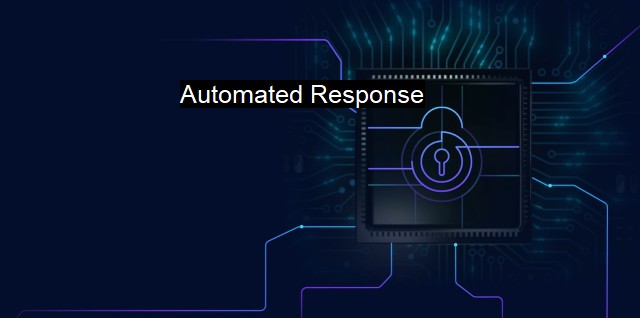What is Automated Response?
Securing Your Business with Automated Response in Cybersecurity and Antivirus: The Essential Guide To Understanding the Basics"
Automated response refers to how computer systems and software, particularly those with built-in, AI-enabled defense mechanisms, respond to threats, attacks, potential breaches or incidents. This technology operates on attributes of speed, intelligence, efficiency and scalability, allowing systems to promptly detect, respond, and remedy cyber threats without necessitating human intervention at each step, thereby safeguarding digital and virtual assets round the clock.In the ever-evolving landscape of cyber threats, traditional IT security measures seldom keep pace. In this situation, the automated response technology is a bulwark against these enigmatic attacks. Cybersecurity teams, already plagued with plenty of false alarms, often run the risk of losing crucial time via the manual response method. Automated response solutions are adept at wading through the sea of false positives, isolating genuine risks, and acting on them instantly. This lightning-fast response constrains the gaping window of opportunities that attackers could potentially utilize, leading to a significantly reduced reaction time.
To detail the functioning, automated response solutions are calibrated based on predefined policies, custom rules, or machine learning algorithms. Their core competencies include quick identification, analysis, and action. Once a threat is identified, the automated system springs into action by isolating the infected networks or devices, preventing the spread of malicious activities. Subsequently, it automatically fine-tunes system settings or update rules to further enhance the defense.
One key aspect of the automated response is its integration with antivirus software. Nowadays, a majority of antivirus software are equipped with automation capabilities to preemptively spot suspicious activities, scan, and neutralize known threats ; all automatically. If an unknown threat creeps into the system, say, a new type of malware, the automated response deploys heuristic methods: using patterns retained from past experiences to detect and alleviate it. Once a remedy is applied, the system updates itself, adding this new threat to its library, strengthening its future response capabilities.
A significant advantage conferred by automated response systems is that it alleviates the overload on the cybersecurity workforce. By automating repetitive low-level tasks such as log monitoring, threat detection, and routine maintenance, it frees up human resources for more complex issues requiring human skill, creativity, and judgement.
Closely tied into the concept of automated response in cybersecurity is Incident Response Automation (IRA). These softwares not only automatically respond to security incidents but also perform next-step actions such as threat intelligence enrichment, forensic analysis, log collection, and alert triage.
It is not all sunshine and roses. On the downside, deep dependence on automated response systems may blur human foresight. If not supervised diligently, automatic actions could disrupt normal business operations. Then there's also the looming risk of these systems being infiltrated and manipulated by advanced malware.
Tools for automated response should ideally harmonize human input and robotic speed. This bridge, known as “semi-automated response,” offers the best of both worlds. It combines the speed of automation with human skills and instincts to execute informed decisions, thereby ensuring seamless security from new and sophisticated cyber threats.
While today's era of digital reliance presents real risks, the advent and sophistication of automated response systems are proving capable of countering these risks. Automation, coupled with artificial intelligence and machine learning, is shaping the future of cybersecurity and antivirus solutions, enabling swift, intelligent and large-scale responsive mechanisms. it is of equal importance to marry these automated advantages with human intervention at critical junctions, thereby striking an ideal balance between defense efficiency and potential system vulnerabilities. All in all, automated response is marking a resurgence heralding smarter, safer networks.

Automated Response FAQs
What is an automated response in the context of cybersecurity?
An automated response in the context of cybersecurity refers to a pre-programmed action that a system or software automatically takes when it detects a security threat or breach. This response is designed to mitigate the risk and prevent further damage without human intervention.How does antivirus software use automated response?
Antivirus software uses automated response by scanning the system for potential threats and taking action automatically when a threat is detected. This includes quarantining or deleting malicious files, blocking suspicious websites, and notifying the user of the threat. Automated response helps the antivirus software act quickly and efficiently to stop cyber attacks.What are the benefits of using automated response in cybersecurity?
Automated response has several benefits in cybersecurity, including faster detection and response times, reduced risk of human error, and cost-effectiveness. It also allows for continuous monitoring and response, even outside of regular business hours. Automated response also ensures consistent and standardized responses to security incidents.Can automated response replace human intervention in cybersecurity?
While automated response can significantly improve cybersecurity measures, it cannot replace human intervention entirely. Some incidents still require human analysis and decision-making, especially in complex or novel situations that the automated response may not be equipped to handle. Additionally, human oversight is needed to ensure that the automated response is functioning correctly and to make any necessary adjustments to security protocols.| | A | | | B | | | C | | | D | | | E | | | F | | | G | | | H | | | I | | | J | | | K | | | L | | | M | |
| | N | | | O | | | P | | | Q | | | R | | | S | | | T | | | U | | | V | | | W | | | X | | | Y | | | Z | |
| | 1 | | | 2 | | | 3 | | | 4 | | | 7 | | | 8 | | |||||||